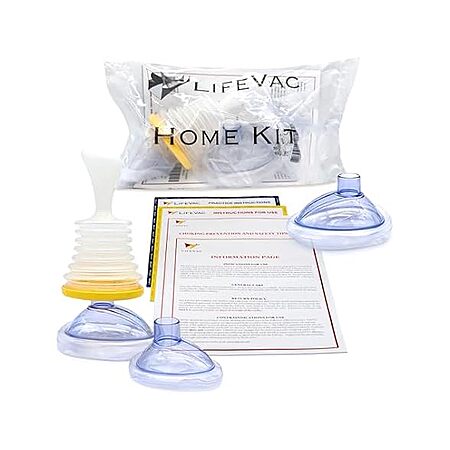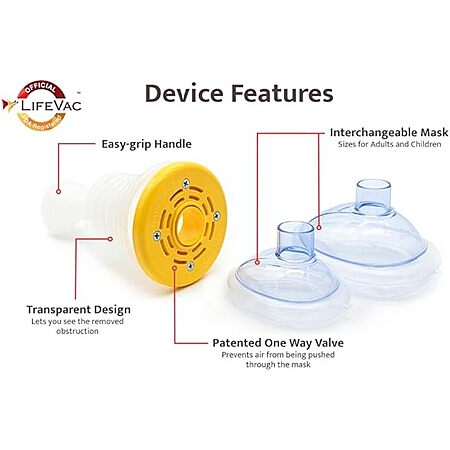Woot has
LifeVac Home Kit Portable Suction Rescue Device on sale for $64.99 - $13 when you apply 20% Off coupon code
JAN2025 =
$51.99.
Shipping is free for Amazon Prime Members (must login with your Amazon account and select a shipping address in order for Woot to apply free shipping) or is otherwise $6 per order.
Thanks community member
TexasSunDevil for sharing this deal
Note, you must apply coupon code during final checkout by clicking "Got a Coupon Code" located under place order to receive this sale price.
About this Product:
- LifeVac is a Patented, non-invasive suction rescue device that can save a life in the event of an air obstruction. Take action and be prepared with the appropriate equipment to protect yourself and your loved ones.
Includes:
- LifeVac suction device with Patented One-way Valve
- Pediatric Mask
- Adult Mask
- Practice Mask
- Instructions for using LifeVac


Leave a Comment
Top Comments
not the same device, but a similar one.
"Results
The DeChoker resulted in gross injury to the tongue and failed to remove the obstruction in all trials. LifeVac was successful in removing the barium‐moistened saltines but failed to remove all other foreign bodies. Both devices applied significant pressure to the tongue.
Conclusion
With the exception of the LifeVac removing saltine crackers, all trials were entirely unsuccessful in relieving foreign body aspiration. Additionally, both devices may cause significant pressure and injury to the oral cavity in a clinical setting. We conclude bystanders should continue to follow International Liaison Committee on Resuscitation's guidelines on resuscitation to aid with relieving foreign body aspiration."
from my reading of EMS forums/sub-reddits: these devices seem pretty universally panned or, at best, regarded as absolute last resort.
one of the big issues that is easy to overlook is that you need a perfect seal, which is tough, ESPECIALLY with a child, ESPECIALLY when they are panicking.
17 Comments
Sign up for a Slickdeals account to remove this ad.
Thanks!
Thanks!
Sign up for a Slickdeals account to remove this ad.
Our community has rated this post as helpful. If you agree, why not thank bsdc
not the same device, but a similar one.
"Results
The DeChoker resulted in gross injury to the tongue and failed to remove the obstruction in all trials. LifeVac was successful in removing the barium‐moistened saltines but failed to remove all other foreign bodies. Both devices applied significant pressure to the tongue.
Conclusion
With the exception of the LifeVac removing saltine crackers, all trials were entirely unsuccessful in relieving foreign body aspiration. Additionally, both devices may cause significant pressure and injury to the oral cavity in a clinical setting. We conclude bystanders should continue to follow International Liaison Committee on Resuscitation's guidelines on resuscitation to aid with relieving foreign body aspiration."
from my reading of EMS forums/sub-reddits: these devices seem pretty universally panned or, at best, regarded as absolute last resort.
one of the big issues that is easy to overlook is that you need a perfect seal, which is tough, ESPECIALLY with a child, ESPECIALLY when they are panicking.
not the same device, but a similar one.
"Results
The DeChoker resulted in gross injury to the tongue and failed to remove the obstruction in all trials. LifeVac was successful in removing the barium‐moistened saltines but failed to remove all other foreign bodies. Both devices applied significant pressure to the tongue.
Conclusion
With the exception of the LifeVac removing saltine crackers, all trials were entirely unsuccessful in relieving foreign body aspiration. Additionally, both devices may cause significant pressure and injury to the oral cavity in a clinical setting. We conclude bystanders should continue to follow International Liaison Committee on Resuscitation's guidelines on resuscitation to aid with relieving foreign body aspiration."
from my reading of EMS forums/sub-reddits: these devices seem pretty universally panned or, at best, regarded as absolute last resort.
one of the big issues that is easy to overlook is that you need a perfect seal, which is tough, ESPECIALLY with a child, ESPECIALLY when they are panicking.
https://www.fda.gov/medical-devic...municat
Recommendations for Consumers, Parents and Caregivers
Always follow established choking rescue protocols approved by the American Red Cross and the American Heart Association before considering other interventions, as these protocols have a high rate of success and can be carried out immediately without devices, saving valuable time.
Choking rescue protocols should only be used when there is complete airway block or the person is unable to cough, because interventions (such as back blows) could convert a partial airway block (which choking victims are usually able to clear on their own) to a complete airway block.
If you choose to use an anti-choking device, only use it after established choking rescue protocols have failed. The safety and effectiveness of over-the counter anti-choking devices have not been established.
Potential Problems with Anti-Choking Devices
The FDA recognizes that anti-choking devices may already be in consumers' homes. Our recommendations are intended to help avoid delaying use of the established rescue protocols listed above if people choose to use these devices.
The FDA is aware of reports describing problems with the use of anti-choking devices, including failure to resolve a choking incident due to lack of suction, bruising around the face, lips, and mouth, and scratches in the back of the throat.
Established choking rescue protocols, such as the American Red Cross and the American Heart Association, have a high success rate. Anti-choking devices typically require removal from packaging and assembly and could delay using established rescue protocols.
Here are the Red Cross Adult and Child choking steps: https://www.redcross.or
General Care: Choking (Adult/Child)
Position self to the side and slightly behind the choking person.
For a small child, you may need to kneel behind them rather than stand.
Give 5 back blows.
Use the heel of the hand to strike between the shoulder blades.
If no improvement, have the person stand up straight.
Move behind the person; bend your knees slightly for balance and support.
Give 5 abdominal thrusts.
Pull inward and upward each time.
Continue giving 5 back blows and 5 abdominal thrusts.
Continue until the person can cough, cry or speak or becomes unresponsive.
If the person becomes unresponsive, lower them to a firm, flat surface and begin CPR (starting with compressions) according to your level of training.
Trained responders: After each set of compressions and before attempting breaths:
Open the person's mouth.
Look for an object.
If seen, remove it using your finger. NEVER do a finger sweep unless you actually see an object.
*My opinion only: A practical consideration is that if the person choking is obese, or much larger stature than the rescuer, then the device could be useful compared to standard back blows and abdominal thrusts. Still, I'd follow the standard guidance first, then use this as a last resort.
Sign up for a Slickdeals account to remove this ad.
I do have a similar device in my medical cabinet (DeChoker) that I have for the "death is imminent" scenario, but like you said, learning proper life saving technique is always the better route.
Leave a Comment